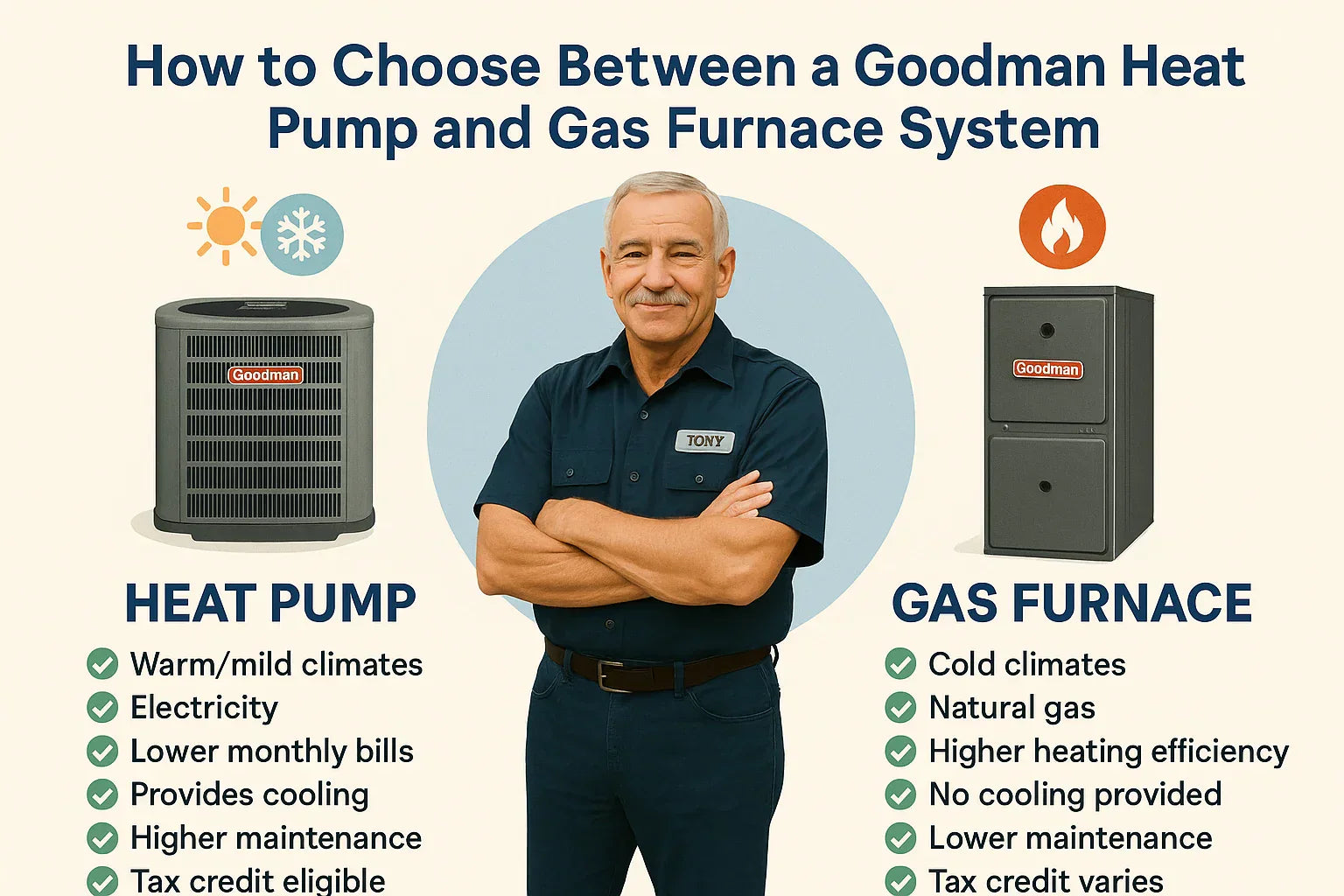🏡 Meet Tony: The Practical Homeowner Making the HVAC Call
Tony had a choice to make. His aging HVAC system finally gave out during a mild South Carolina winter, and he needed a new one fast. With rising energy prices and conflicting advice from HVAC forums and contractors, he wanted to make the right long-term decision. The contenders? A Goodman heat pump or a Goodman gas furnace and air conditioner combo.
In this guide, we follow Tony’s journey—and arm you with everything you need to confidently choose between these two options.
🌍 Climate Considerations: Where You Live Changes Everything
❄️🔥 Heat Pumps vs. Gas in Different Regions
Heat pumps are incredibly efficient—especially in moderate or warm climates—because they transfer heat instead of generating it. But when the temperature drops below freezing, gas furnaces often outperform them in heating power and speed.
| Region | Best Option |
|---|---|
| South & Southwest | Heat Pump |
| Mid-Atlantic & Midwest | Depends on winter lows |
| Northeast & Upper Midwest | Gas Furnace or Dual Fuel |
If your winters are mild (lows rarely below 30°F), a Goodman heat pump may cover all your heating and cooling needs.
📌 Resource: Energy.gov - Climate Zone Maps
💵 Upfront Costs: What You'll Pay for Equipment + Install
💰 Cost Comparison: Heat Pump vs. Gas Furnace System
Tony requested bids from three contractors. Here’s the average pricing he saw:
| System Type | Average Equipment + Install Cost |
| Goodman Heat Pump (15.2 SEER2, 3 Ton) | $7,200 |
| Goodman Gas Furnace + AC Combo | $8,600 |
| Goodman Dual-Fuel System | $9,800 |
Factors affecting cost:
-
Size (tonnage / BTUs)
-
SEER2 and AFUE ratings
-
Local permit and labor fees
-
Thermostat upgrades and ductwork
📌 Resource: Modernize HVAC Cost Guide
🔌 Monthly Energy Use: Electricity vs. Natural Gas
⚡ Utility Bills by Region
A heat pump uses electricity year-round, while a gas furnace uses gas in winter and AC uses electricity in summer. Tony compared his bills before and after switching.
His results:
-
Old gas furnace + 10 SEER AC: $340/mo in peak seasons
-
Goodman 15.2 SEER2 heat pump: $260/mo peak
Depending on local rates, your savings may vary:
| Region | Electricity Cost (per kWh) | Natural Gas Cost (per therm) |
| South | $0.12 | $1.30 |
| Midwest | $0.15 | $1.10 |
| Northeast | $0.20 | $1.40 |
📌 Resource: EIA - Average U.S. Energy Prices
🌡️ Comfort: What Feels Better?
🌬️ Heat Pumps = Gentle & Consistent, Gas Furnaces = Fast & Intense
-
Heat Pumps gradually warm your home and maintain a steady temp
-
Gas Furnaces heat faster and produce warmer air blasts
Tony said: “The heat pump never made the house hot—it just stayed comfortable. And that’s what I needed.”
In very cold climates, heat pumps rely on backup heat (electric strips or dual-fuel setups) which can increase your bills.
🔧 Maintenance & Longevity
🧰 What Breaks, and What Lasts
Heat Pump:
-
Runs all year (heating & cooling)
-
More wear on compressor & reversing valve
-
Lifespan: 10–15 years
Gas Furnace:
-
Runs only in winter
-
Simpler mechanics
-
Lifespan: 15–20 years
Both systems require:
-
Quarterly filter changes
-
Annual coil cleanings
-
Biannual system checks
Goodman backs both systems with 10-year parts and lifetime compressor or heat exchanger warranties.
📌 Resource: Goodman Warranty Info
🏆 Energy Efficiency & Tax Incentives
💵 Which Qualifies for Energy Rebates?
Goodman heat pumps with SEER2 > 15.2 and HSPF2 > 7.8 may qualify for:
-
Federal Tax Credit: Up to $2,000 (Inflation Reduction Act)
-
ENERGY STAR rebates
-
Local utility incentives
Gas furnaces with 95%+ AFUE may also qualify, but benefits are typically smaller.
📌 Resources:
🔄 What About Dual-Fuel Systems?
♻️ Best of Both Worlds
A Goodman dual-fuel system combines a heat pump with a high-efficiency gas furnace:
-
Heat pump runs during mild temps
-
Furnace takes over during extreme cold
-
Controlled via smart thermostat or outdoor sensor
Best for:
-
Midwestern, mountain, or Northeastern climates
-
Homeowners wanting high efficiency + backup protection
📊 Goodman Model Comparison
| Feature | Goodman Heat Pump | Goodman Gas Furnace + AC |
| Heating Source | Electric | Natural Gas |
| Cooling Included | Yes | AC unit required |
| Best Climate | Warm to mild | Cold to freezing |
| Efficiency Ratings | Up to 18.2 SEER2 | Up to 98% AFUE |
| Comfort Level | Steady warmth | Fast, strong heat |
| Maintenance | Higher | Lower |
| Rebates | More available | Limited |
✅ Final Checklist: Which One’s for You?
Use this decision matrix:
-
🌡️ Winters above 30°F? → Heat Pump
-
❄️ Winters below 20°F often? → Gas Furnace
-
🧾 Want lower electric bills? → Heat Pump
-
💨 Want faster heating response? → Gas Furnace
-
🔁 Want best of both? → Dual-Fuel System
🛠️ What Tony Chose—and Why
Tony went with the Goodman 3 Ton 15.2 SEER2 Heat Pump with Air Handler, plus an auxiliary electric heat strip.
“In South Carolina, I didn’t need to overpay for a gas line I’d barely use. The heat pump keeps my home at 70°F all winter and runs quietly in the summer. Best decision I made.”
Still deciding?
Explore both options on The Furnace Outlet – Goodman HVAC Systems and use Tony’s logic to choose the one that fits your home and your climate.
In the next topic we will know more about: Goodman vs. Carrier vs. Trane: Which Brand Delivers More Value?







